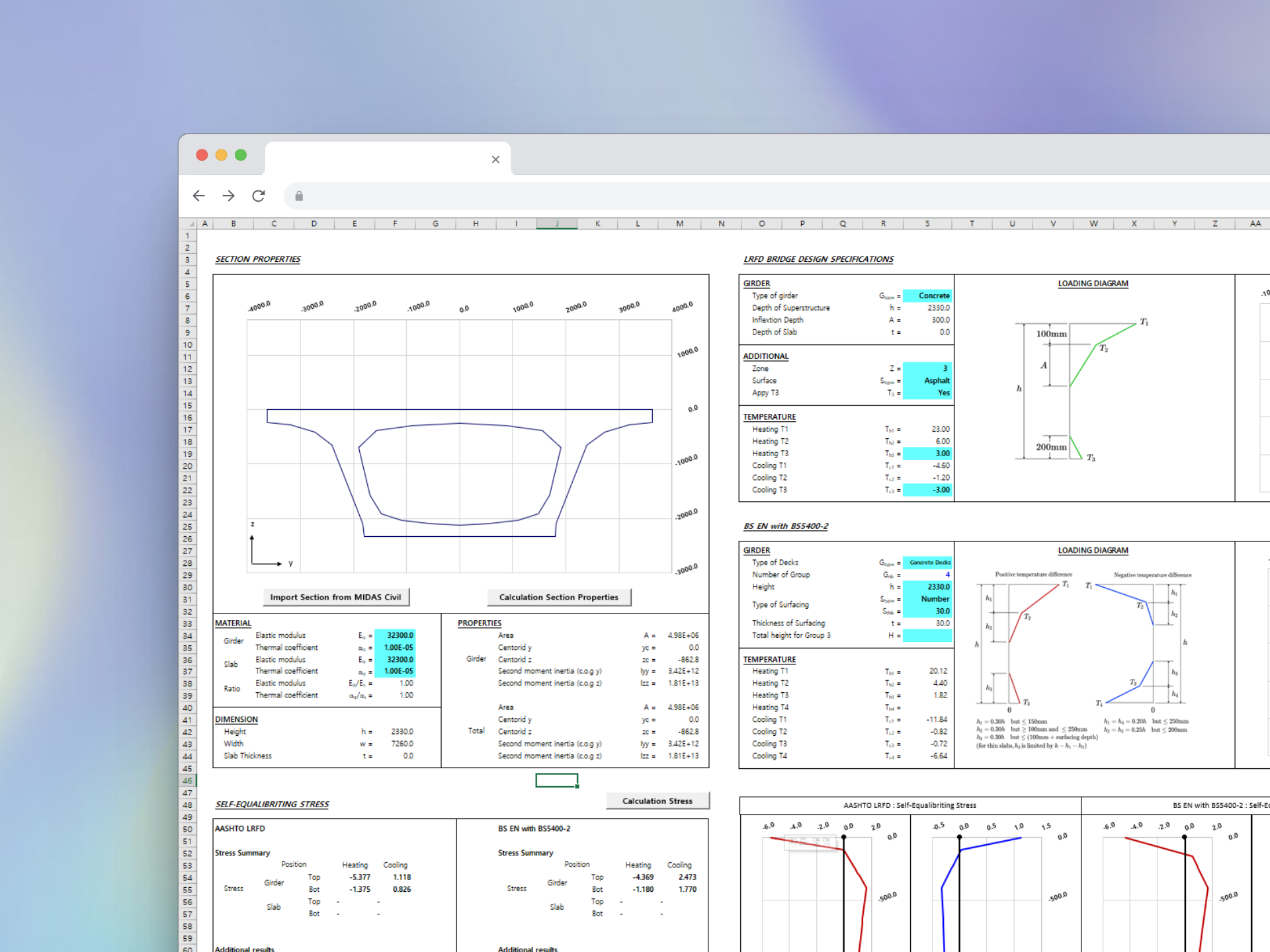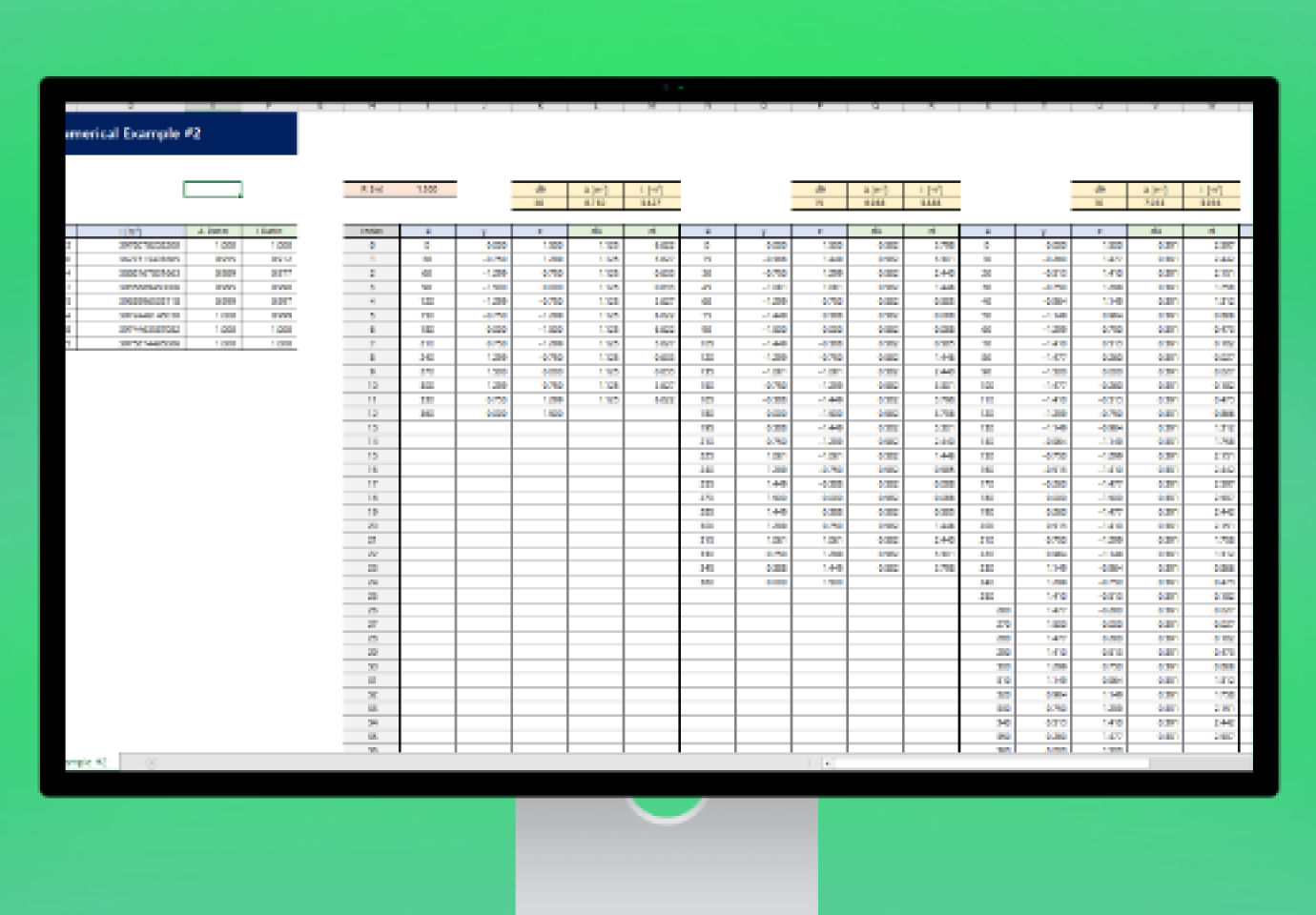📢 To check the entire series, click here
- Non-linear Temperature Gradient Part 1. AASHTO LRFD
- Non-linear Temperature Gradient Part 2. BS Code & Eurocode
- Non-linear Temperature Gradient Part 3. Effects on Beams
- Non-linear Temperature Gradient Part 4. Effects on Bridges
2. BS EN 1991-1-5:2003
(1) Vertical temperature components with non-linear effects
In BS EN, the temperature gradient load for bridges is described in section 6.1.4.2, "Vertical temperature components with non-linear effects (Approach 2)," of BS EN 1991-1-5. The load is specified differently depending on the type of bridge deck, which can be steel, composite, or concrete.
In addition to these rules, the magnitude of the temperature gradient load also varies depending on the thickness of the pavement and the height of the structure. This information is provided in Appendix B of BS EN.
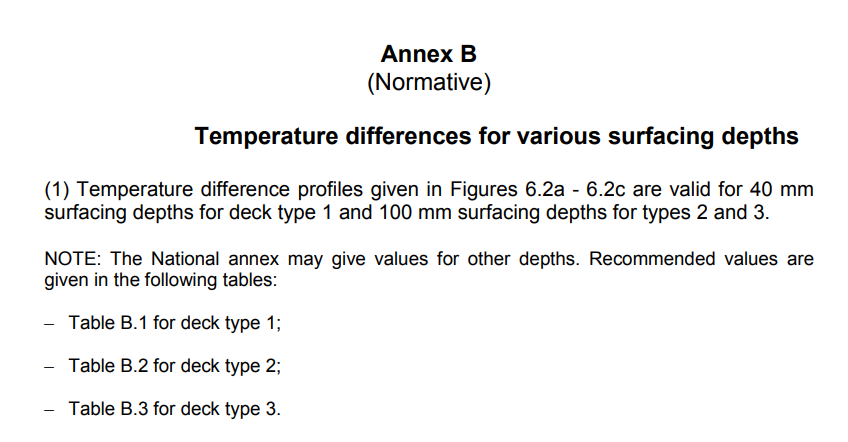 BS EN 1991-1-5 Annex B
BS EN 1991-1-5 Annex B
It should be noted that the temperature gradient load provided in BS EN is inherently more complex than that of AASHTO LRFD, and there are several errors and incomplete parts, making it difficult to calculate the load.
Therefore, let's look at BS 5400-2:2006 together, and determine the correction and load calculation method for it.
For reference, the latest information on this load can be found in CS 454 - Assessment of highway bridges and Structures provided by DMRB (Design Manual Road Bridge).
Type 1: Steel deck
The steel deck provides 4 types of load depending on the girder shape and temperature. The temperature based on thickness is divided into three categories: unsurfaced, 20mm, and 40mm.
Problem
-
In the case of 1b, the temperature according to the surfacing thickness is not provided.
Modification
-
In BS 5400-2, 1b is separated into group 2, and a table showing temperature changes according to surfacing thickness is provided, so it should be applied accordingly.
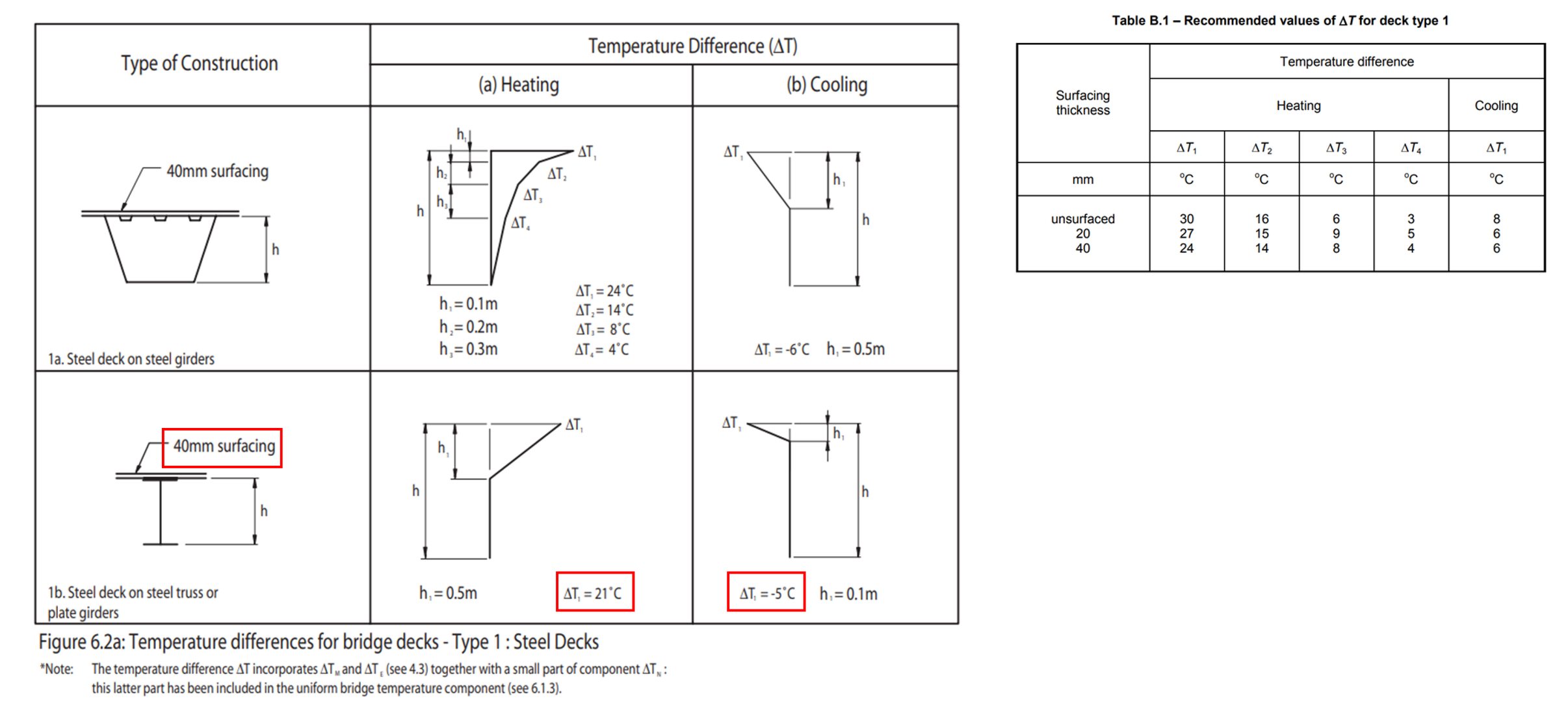 BS EN 1991-1-5 Figure 6.2a & Annex B Table B.1
BS EN 1991-1-5 Figure 6.2a & Annex B Table B.1
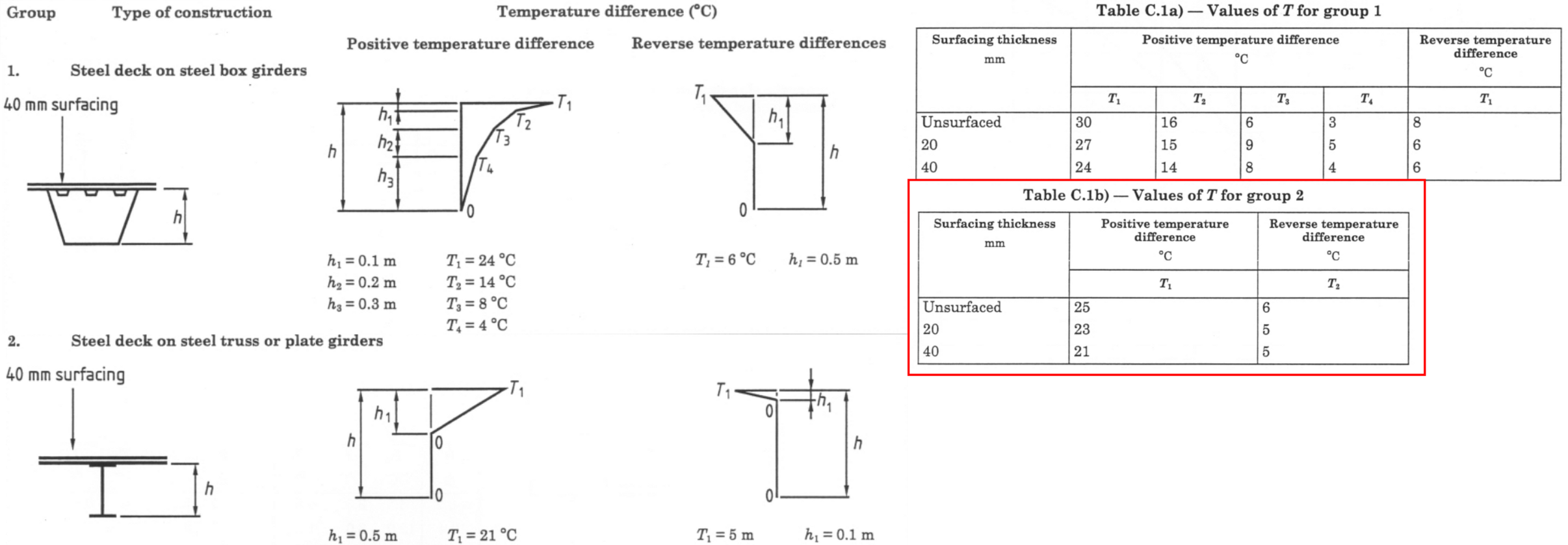
BS 5400-2 Figure 9 & Annex C Table C.1a & C.1b
Type 2: Composite deck
The composite deck has a total of four different temperature gradient load categories which are divided based on Normal/Simplified procedures and temperature effects. Additionally, ten sets of temperature gradient loads are provided taking into account the variation of surfacing thickness according to the height of the slab.
Problem
-
In "Heating", it is expressed as "h2" and is applied across the entire cross-section.
-
In Cooling, the lengths for h1 and h2 are missing.
-
Regarding T2, although the diagram shows 4℃/-8℃ for a 100mm surfacing, no table is provided for other conditions.
-
There is no table provided for slab depth and pavement thickness in the Simplified Procedure.
Modification
-
Heating insets are replaced with those of BS 5400-2.
-
The length is applied in the same way as heating.
-
T2 uses 4℃/-8℃ as a fixed value.
-
It is not used in the case of the simplified procedure.
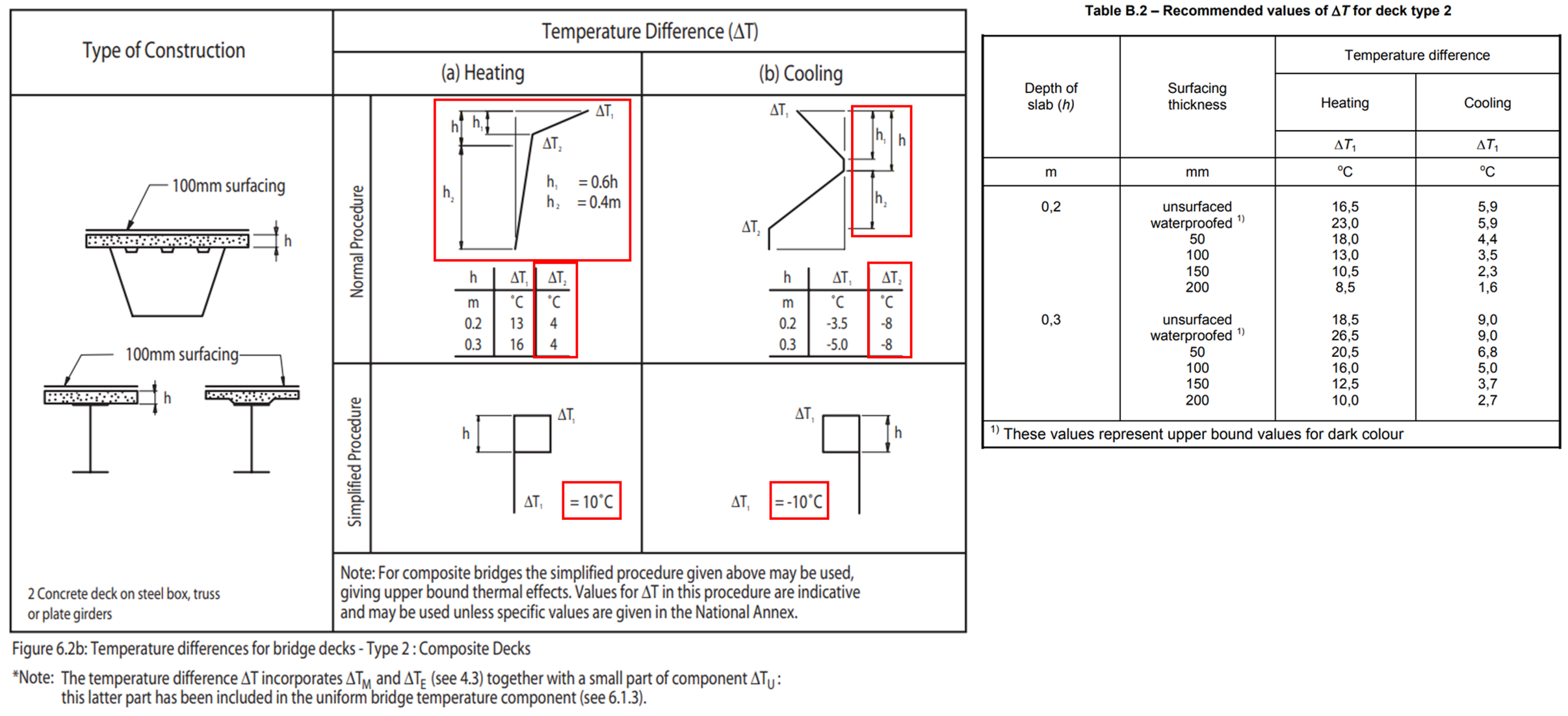
BS EN 1991-1-5 Figure 6.2b & Annex B Table B.2

BS 5400-2 Figure 9 & Annex C Table C.2
Type 3: Concrete deck
Loads are provided in two types according to temperature, but 36 sets of temperature gradient loads are provided according to the section height and pavement thickness, so several linear interpolations are required to apply them.
Problem
-
In Heating, when h is more than 0.8, it is indicated as 13.0℃, but in Annex Table B.3, it is indicated as 13.5℃.
-
In Cooling, the range notation of h3 is incorrect.
-
In cooling, h2/h3 is set to be larger than 0.20m.
-
In B.3 Table, although Cooling T1 is indicated as 4.3 for a slab depth of 1.0m and surfacing thickness of 200mm, it should be interpolated to the intermediate value for the depth of 0.8/1.5.
Modification
-
It is applied in accordance with BS 5400-2, as 13.5°C.
-
Range notation follows BS5400-2.
-
In Cooling, h2/h3 is set to be less than 0.20m.
-
It is revised to 4.8 instead of 4.3.
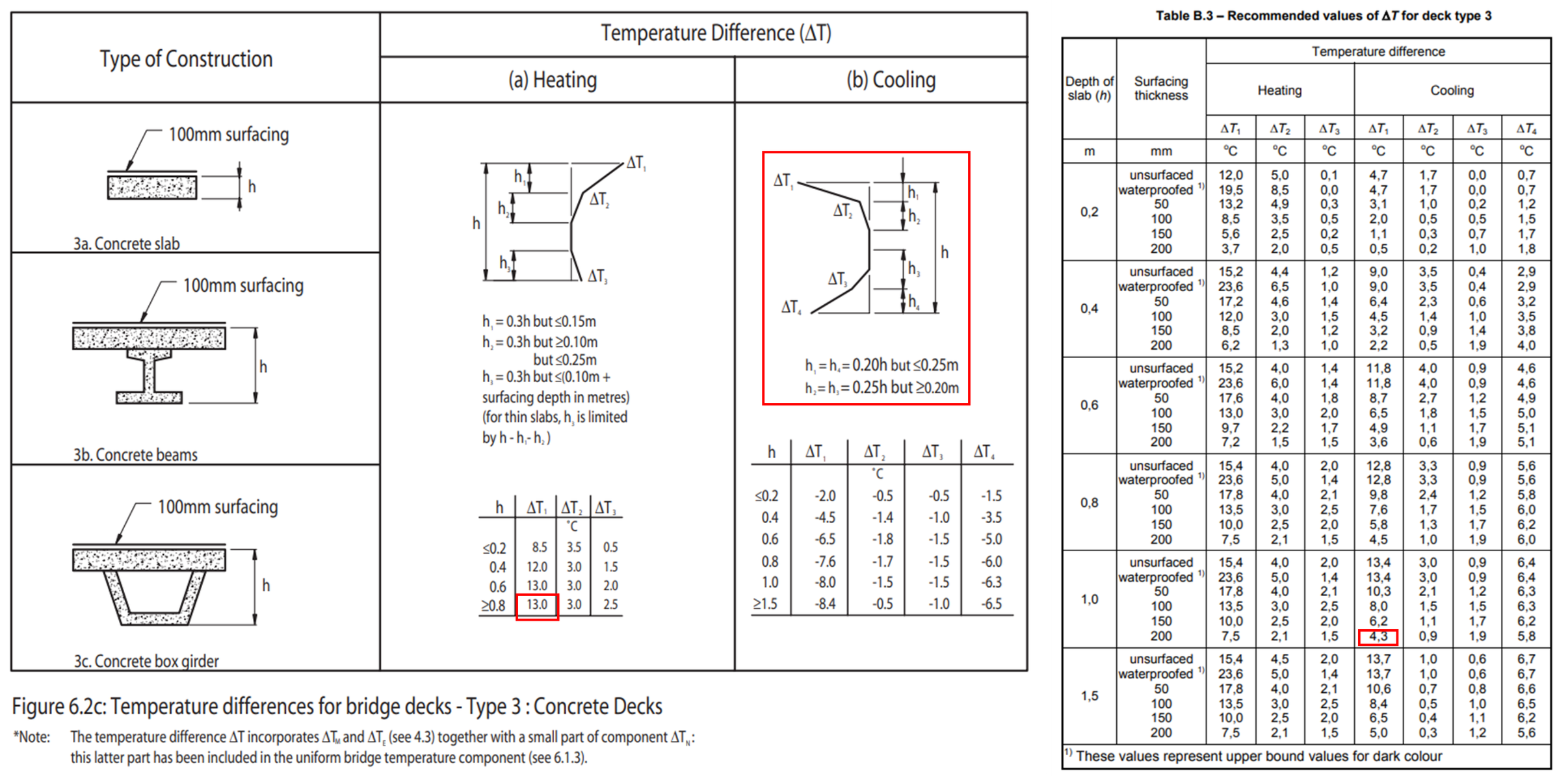
BS EN 1991-1-5 Figure 6.2c & Annex B Table B.3
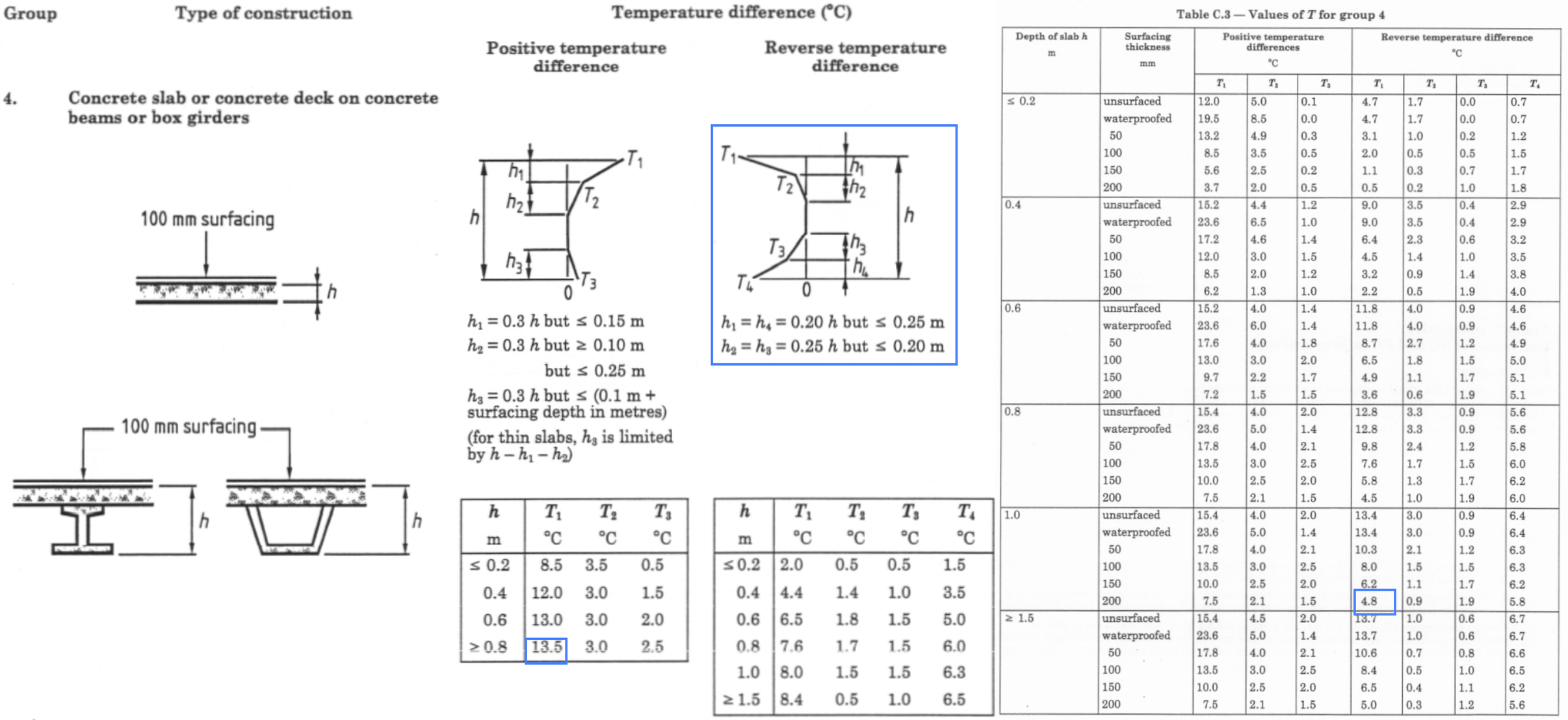
BS 5400-2 Figure 9 & Annex C Table C.3
Temperature load interpolation
There are no guidelines other than the specified slab height and surface thickness. However, based on experience, linear interpolation within the range is acceptable. linear interpolation is performed within the range and the closest value is taken for the value exceeding or less than this.
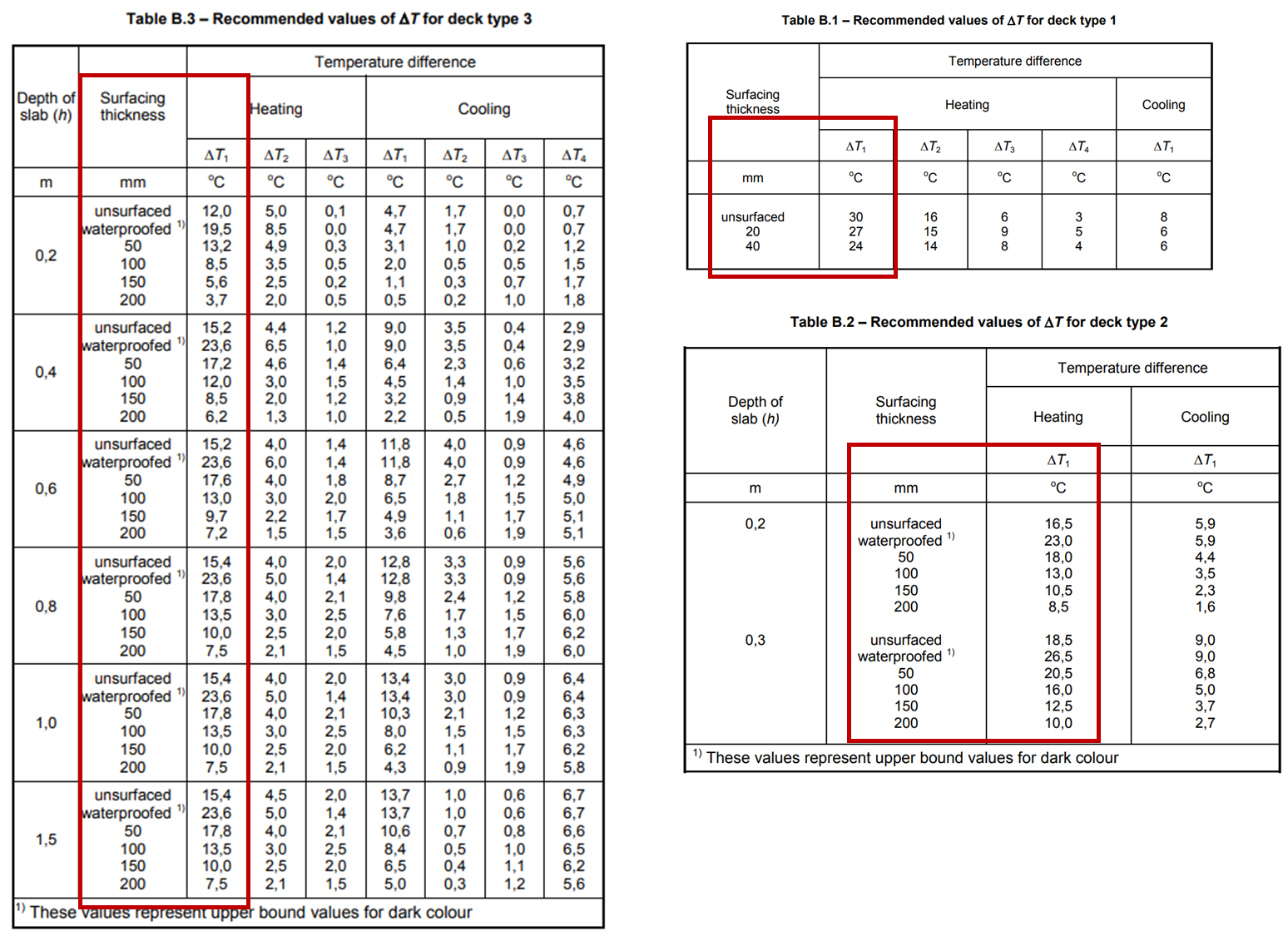
BS EN 1991-1-5 Annex B. Table B1 to B3
Conceptually, the temperature load on the top surface of a slab decreases as the thickness of the surface increases.
In the case of Type 2 & 3, when the thickness is unsurfaced, i.e., zero, the value is calculated to be smaller than when there is thickness. Then, in the case of types 2 & 3, should the unsurfaced and 50mm be interpolated for the surface thickness of less than 50mm? A question may arise.
This can be seen by referring to BS 5400-2, which specifies that the surfaced thickness includes waterproofing thickness. This means that Types 2 & 3 can be divided into two types of surfaces: one with waterproofing and another without any surfacing.
Therefore, for sections with a surfacing thickness of 50mm or less, it is necessary to interpolate the value between waterproofing thickness and 50mm, and CS454 provides accurate information on this.
%20Non-linear%20Temperature%20Gradient%20Part%202%20-%20BS%20Code%20and%20Eurocode/fig%209%20BS%205400-2_2006%20Annex%20C.png?width=2092&height=576&name=fig%209%20BS%205400-2_2006%20Annex%20C.png)
BS 5400-2:2006 Annex C

CS 454 Appendix D2.3
Temperature load combination
In the load combination of BS EN, the uniform temperature and temperature difference are not separately dealt with, but expressed as one “Thermal action”.
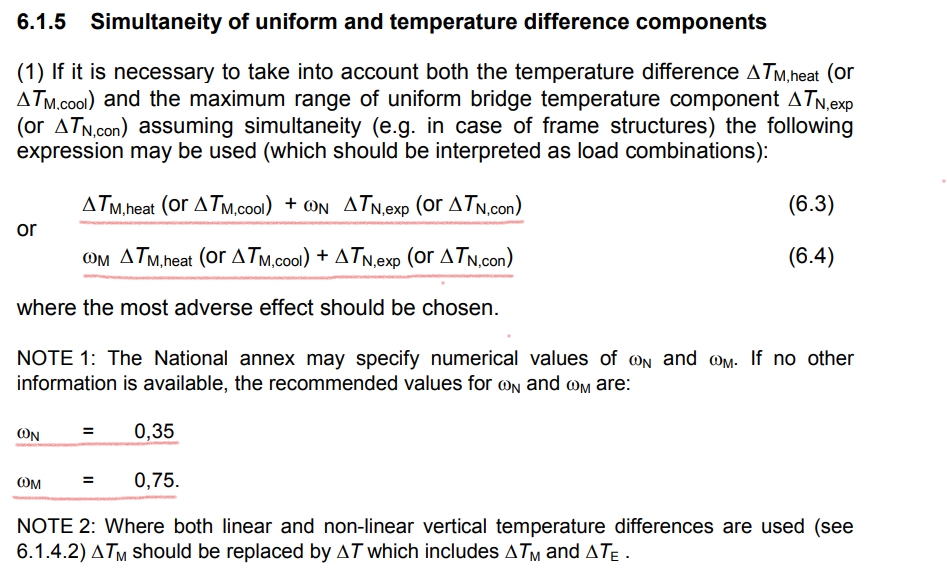
BS EN 1991-1-5 6.1.5
(2) Thermal Gradient Load Calculation - BS EN
Based on the above, the calculation sheet for determining the temperature gradient load can be prepared as follows:
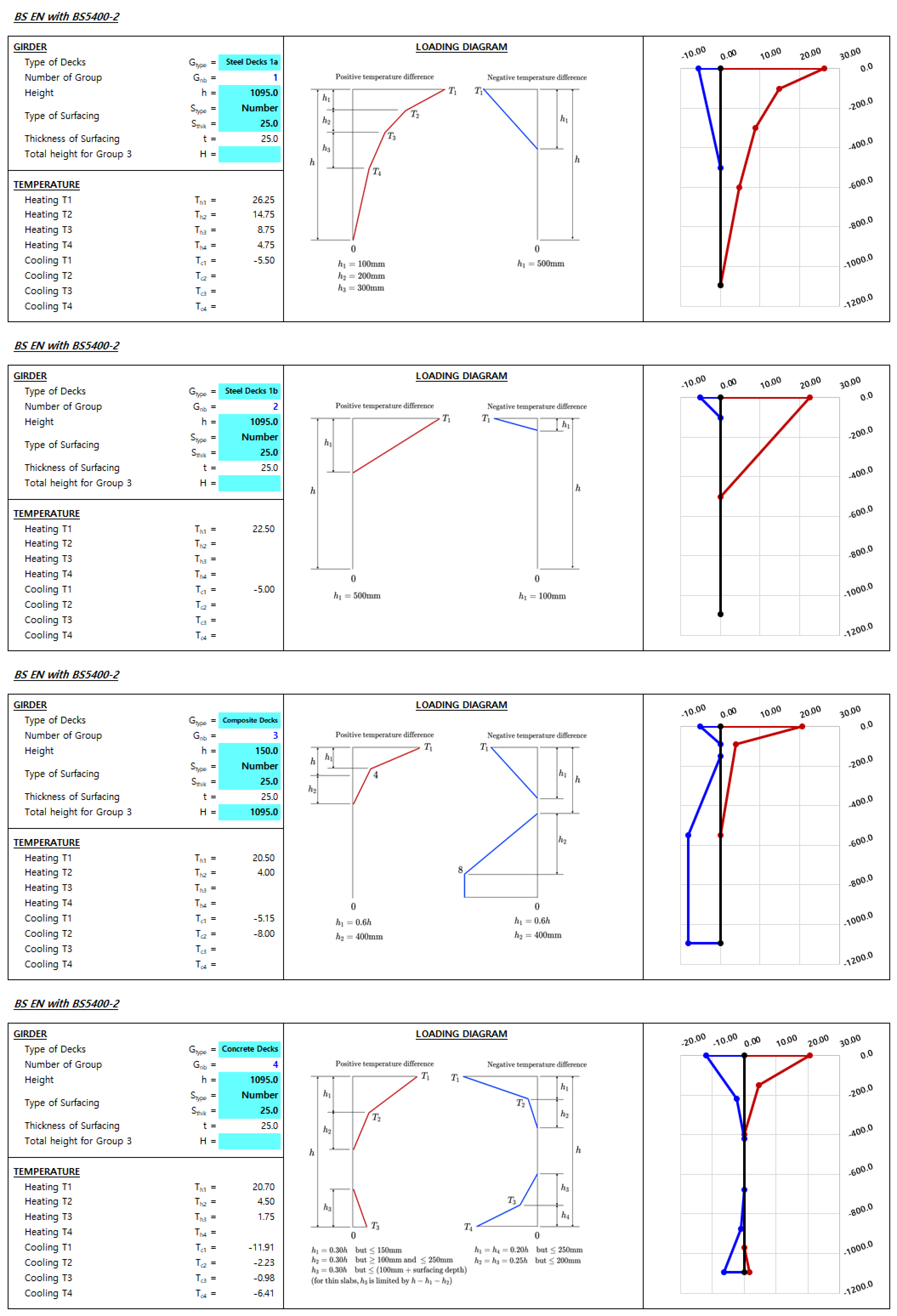
Calculation Example by Deck Type
(3) Conclusion
BS EN 1991-1-5 covers a wide variety of applications for temperature gradient loads based on the shape and variation of temperature. However, it has inherent errors that can be confusing for engineers encountering the standard for the first time. Therefore, it is necessary to compare it with BS 5400-2:2006 to understand it better.
If possible, It is recommended to apply the latest information contained in DMRB CS454 as much as possible.
Imbsen, Roy A., et al. Thermal effects in concrete bridge superstructures. National Cooperative Highway Research Program, 1985.Shushkewich, Kenneth W. "Design of segmental bridges for thermal gradient." PCI journal 43.4 (1998): 120-137.AASHTO, LRFD Bridge Design Specification, Ninth Edition, American Association of State Highway and Transportation Officials, Washington, D.C., 2020.AASHTO, LRFD Bridge Design Specification, SI Units, Fourth Edition, American Association of State Highway and Transportation Officials, Washington, D.C., 2007.BSI, BS EN 1991-1-5, Eurocode 1 : Actions on structures - Part 1-5: General actions - Thermal actions, British Standard Insititution, London, 2003.BSI, BS 5400-2, Steel, concrete and composite bridges - Part 2: Specification for loads, British Standard Insititution, London, 1978.BSI, BS 5400-2, Steel, concrete and composite bridges - Part 2: Specification for loads, British Standard Insititution, London, 2006.England, Highways, CS 454 Assessment of highway bridges and structures, The National Archives, Kew, London, 2022.Emerson, Mary. Temperature differences in bridges: basis of design requirements. No. TRRL Lab Report 765. 1977.
Would you like to use the mentioned Excel Spreadsheet in the content?
Submit the form below right away, and receive the file for calculating temperature gradient loads.
(Note! This spreadsheet requires access to the MIDAS CIVIL API for utilization.
If you have any inquiries regarding the CIVIL API, please feel free to leave a comment.)
👉🏻 Download Now
🗳️ Quick Poll!
Stay tuned for the unveiling of results next week! 📆
 Get Started midas Civil
Get Started midas Civil
 Featured blog of this week
Featured blog of this week







